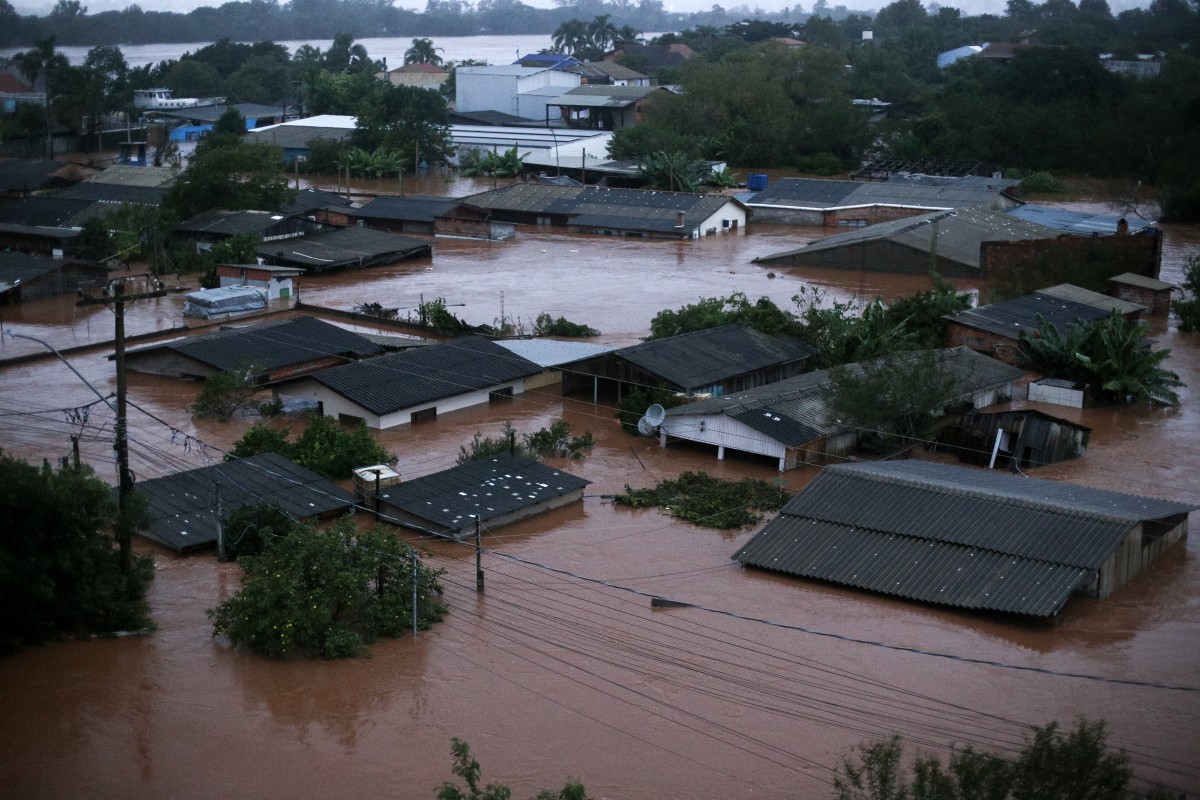Hatches mais vendidos: VW Polo dispara e Argo e HB20 tentam acompanhar.txt
The_rewilding_milestone_Earth_has_already_passed.txt
The resultado jogo do bicho 14h de hojerewilding milestone Earth has already passed3 days agoShareSaveJoseph Poore, Hannah Ritchie and Charles GodfrayShareSaveGetty Images(Credit: Getty Images)Sustainability and food researchers Joseph Poore, Hannah Ritchie and Charles Godfray look at places where shrinking farmland has freed up land for nature – and ask how far the trend could go.Throughout the 20th Century, humanity demanded more and more land leading to the loss of vast areas of natural forest and grassland. Today, around half the world's land is farmed, used to grow crops or graze animals.However, according to the UN's Food and Agriculture Organization (FAO), global agricultural land use peaked in the early 2000s and has been slowly falling ever since. Around the world, farmland is being replaced by grasslands, trees and bush. Wild animals are returning to abandoned pasturelands in areas they had once dominated.Reaching "peak agricultural land" does not mean the problem of deforestation is solved. Growing demand for products like beef, soy, cocoa and palm oil has put increasing pressure on land across South America, South East Asia and Africa. In the last decade, the world lost an area of tropical forest twice the size of Spain.Still, acre-for-acre across the world there has been yet more farmland abandonment, driven by reforestation in Europe and North America and the abandonment of pastures in Australia and Central Asia.AlamyWe may have passed "peak agricultural land", but whether that land is then turned to nature depends on several choices (Credit: Alamy)There are a few different reasons for this. Firstly, farming has become more efficient. The use of improved seeds, fertilisers, pesticides and irrigation has in recent decades vastly increased how productive the land we farm is, doubling, tripling and even quadrupling yields depending on the crop and country. Since 1961, FAO data shows that productivity increases have spared 1.8 billion hectares (4.4 billion acres, or around 35 Spains) of land from being brought into cultivation.We've also squeezed more efficiency improvements in animal agriculture through intensive farming, productive animal strains and optimised feeding regimes. As these systems intensified, lower productivity lands have been abandoned in many countries.But it's not all about intensification. We have also replaced some land-hungry crops with near-landless alternatives: wool and cotton have been to a major extent replaced by synthetic fibres; tobacco is rapidly being replaced by synthetic nicotine; flavourings in food such as vanilla are now largely synthetic; the global caffeine (although not coffee) market is dominated by production in labs; synthetic sweeteners have replaced substantial amounts of sugar cane and sugar beet. We estimate that these synthetic substitutes have spared over 110 million hectares (two Spains) of land from farming.Getty ImagesFarming crops such as vanilla takes significant land, but synthetic alternatives are increasingly popular (Credit: Getty Images)One particularly striking example is the shrinkage of the global wool industry. Production has fallen by around 50% from its peak in 1990. Grazing lands in Australia, New Zealand and Argentina – countries that use to be amongst the largest wool producers – have declined by 25%. Large areas of pasture have returned to nature, some of which is actively protected and home to unique species. For example, the huge 70,000 hectare (173,000 acre) White Wells sheep farm in Australia is now the Charles Darwin Reserve, home to 700 species of plant and 230 animals. Another 70,000 hectare (173,000 acre) area in Argentina, previously the Chacabuco sheep ranch, is now a nature reserve and home to the rhea or ?andú, an uncommon bird related to ostriches and emus. There are many similar examples worldwide.While the use of synthetic alternatives has taken pressure off land, they have come with other issues, particularly plastic pollution and an increased reliance on fossil fuels. There are solutions to these new problems however, such as landless biodegradable bio-plastics based on fungal mycelium or microbial processes, and they are beginning to scale up. Further, while agricultural land use has declined, not all of it has been replaced by natural forests; there has been a huge growth in plantation forestry for timber products worldwide, and plantation forests generally harbour much less biodiversity than natural forests.Overall, the steady slowdown in agricultural land use is welcome. However, it's not guaranteed to continue, nor is it fast enough to bring about the land use change we need to achieve our global climate or biodiversity goals. To keep global temperature rise below 2C, we will need to tap the huge potential of our natural ecosystems to suck carbon out of the atmosphere.What will happen in the future? We think current trends are likely to continue, with more and more land previously used for agriculture being freed up across the world. But this process could also accelerate further due to a range of promising technologies and solutions which could produce transformational change to our food systems, reducing land used for food production even more. Some of these are close to being a commercial reality; others are still just ideas in research labs.What we can expectBased on historical trends and future forecasts, it is likely that crop yields will continue to increase globally on average. In 1961, we produced just over one tonne of grain per hectare (0.4 tonnes per acre). We now produce over four tonnes per hectare (1.6 tonnes per acre).Yields are still increasing in most crops and countries, with more food grown each year on the same land, while fallow periods (time where land is left bare) are decreasing. However, a critical unknown is climate change: depending on how much climate action we take, warmer, wetter and more extreme climates could negatively affect yield growth, particularly if we don't adapt and develop more climate-resilient crops.Getty ImagesIn Argentina, the rhea is one bird that has benefitted from the trend of releasing land to nature (Credit: Getty Images)While global meat consumption is rising rapidly, driving increased demand for land, we are seeing evidence of consumers swapping from beef and lamb – which use substantial amounts of land per kilogram – to pork and poultry, which use a lot less land. In Europe we have seen a 20% reduction in beef and lamb and a 20% increase in poultry and pork since 2000, sparing around 20 million hectares (49 million acres - around one Spain) of land.This swap raises ethical concerns, as we need to kill many more chickens to get the same quantity of meat as we do from cows. Nevertheless, it seems likely that people will continue to swap towards lower cost, and generally lower land use, animal products.Lab-grown foodsAnother, albeit less certain, way land use for farming could drop in the coming decades is a rise in the use of synthetic and lab-grown foods.While several landless substitutes for crops have become mainstream, such as synthetic vanilla flavour and synthetic fibres, many more have been developed and tested. Synthetic substitutes for oils and fats, for example, have existed since the 1940s, when margarine was first synthesised from fossil fuels in wartime Germany. We have eaten and drunk the products of small-scale microbial fermentation for millennia (such as yoghurt and beer) but modern bulk fermentation could be transformative, particularly if it uses feedstocks which don't require land (such as waste streams, by-products, or through the direct use of elemental nitrogen, oxygen, and hydrogen). We also have lab-produced substitutes for coffee and cocoa. While they currently use sugars as the feedstock, these can be much less land demanding than when conventionally produced.External forces would likely be needed to increase the adoption of these, such as price shocks (which are more likely due to climate change), changing trade policies, or increasing concern about the deforestation caused by oils, coffee and cocoa.The adoption of lab-grown or synthetic substitutes in animal feed is also likely. Pasture use and crops grown to feed animals make up around 80% of the world's farmland, so substituting these feeds would have transformative effects. The major challenge is cost, however. Bacterially derived lab-grown animal feeds have been successfully tested but are still prohibitively expensive. We are seeing rapid reductions in prices of lab-grown alternatives though, and they might reach cost competitiveness soon.An open questionThere are other possibilities that we are less certain will happen but are still plausible.An increase in the use of lab-grown food for human consumption is one. There have been rapid reductions in the cost of lab-grown meat, dairy and eggs. In 2013, the first lab-grown meat cost over $1m per kg (£740,000 per kg). By 2030, it is expected to cost around $6 per kg (£4.50 per kg), bringing it close to the price of beef.Getty ImagesLab-grown meat could potentially take up vastly less land than conventional meat (Credit: Getty Images)However, to use it in human food we also need lab-grown products to taste good and be accepted by consumers. This is a much longer journey and may require some external shocks or societal changes in sentiment. Maybe young people will change how they view the killing of animals for food. Maybe pandemic risks from farmed animals will get more attention. Currently it remains unclear.New technologies in farming could also make food production yet more efficient. Globally, food grown in greenhouses, for example, is rapidly expanding. Greenhouses can produce much more food than open fields: Dutch greenhouses, for example, can produce around 500 tonnes of tomatoes per hectare (200 tonnes per acre), compared with 30 tonnes per hectare (12 tonnes per acre) in open fields.Vertical farming takes this further by stacking layers of crops on top of each other and using exclusively artificial sources of energy. Today, producing most crops in vertical farms would be far too expensive and vertical farms only work for high-value crops like herbs and leafy greens. The cost of energy would need to plummet for them to be adopted at scale, and to avoid this worsening climate change, the energy sources would have to be low-carbon renewables.Transformative changeAchieving even just a few of these disruptions could bring huge ecological benefits, freeing up large amounts of land for natural ecosystems to rebuild, support biodiversity and store carbon. Many of them could also improve food security, which will become increasingly important with a changing climate.More like this:? The people 'meadowscaping' their lawns? Rewilding death: Germany's plan to restore the necrobiome? The rewilded golf courses teaming with lifeHowever, as we free up land, other competing land uses may take its place. Urban land represents around 1% of global area, and it seems unlikely this will replace farmland at scale (although in areas with high demand for housing and infrastructure it could). A major risk however is that plantation forestry and biofuels will further increase in area. Historical environmental policies have created demand for biofuels and wood-based products as sustainable alternatives, but much scientific research has called for better solutions. For sustainable change, new solutions should not carry these trade-offs. Electric cars, for example, are a better alternative to biofuel-based cars.We also need to be honest about the downsides of these transitions. Farmers in many countries would be hit hard as certain parts of the market disappear, so ensuring they are supported to create new livelihoods is critical. Animal welfare could be (although not inevitably be) further compromised by a shift to higher intensity production.These innovations will also only improve food security if they're affordable for people on low incomes. Otherwise, they risk widening global food inequalities, rather than reducing them.None of these changes are inevitable. In fact, it's plausible that things move in the opposite direction, and agricultural land starts expanding again. There could be a scramble for land to produce biofuels for aviation or shipping. We could see a pushback against harmful processed foods stymying the development of processing that improves nutritional value, and offers healthier alternatives to current food products. Rollbacks of environmental policies that protect natural lands, meanwhile, could lead to croplands and pasture expanding into vital areas for biodiversity.But if we can get the transition to an increasingly landless agricultural system right, it could make the 21st Century a turning point in human history. In fact, we could be living in the first century in recent times where we leave the planet with more nature than it had before.--For essential climate news and hopeful developments to your inbox, sign up to the Future Earth newsletter, while The Essential List delivers a handpicked selection of features and insights twice a week. For more science, technology, environment and health stories from the BBC, follow us on Facebook and Instagram. EarthFoodAgricultureNature & OutdoorsWildlifeRewildingEcologyEnvironmentFeatures














